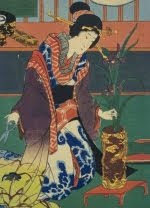Some say that ikebana and chabana (tea flowers) are two different concepts. The purpose of chabana is to help creating a harmonious atmosphere for the tea ceremony by bringing an element of nature into the setting. The flowers have to be absolutely fresh, helping you to rest in the moment of nowness. When arranging them, the flowers needs to be treated with care and respect, but when the tea ceremony is over the task of the flowers is so aswell. There is no point in preparing them to live longer as one does in ikebana.

On the other hand chabana and ikebana are deeply related. In his book "Kadensho" Sofu Teshighara describes the two main lines of development in the history of ikebana using the terms Rikka and Chabana. I think what he means is that as much as the Rikka arrangements are formal, strict and showy, the Chabana is humble and appearently spontanuos. The carachter of chabana from this point of view is that it is a smaller free style arrangement. A more common way of describing this historical development is to name the two main lines Tatehana, meaning "standing" or "upright" flowers, and Nageirebana, meaning "trown in" flowers.
In my opinon it is correct to say that chabana developed together with the less formal "trown in" style of ikebana. Chabana is indeed a special category of ikebana. It is related to the simplified ikebana styles that are also tought today, but it is the special setting of the tea ceremony and the estetic ideals of the old tea masters that defines the many rules of chabana.
Photo: Chabana by Lisbeth Lerum, photo by Nordic Lotus.
Kadensho: The book of flowers
by Sofu Teshigahara
Sogetsu Shuppan, Tokyo, 1979




















